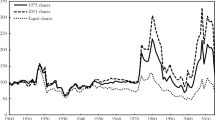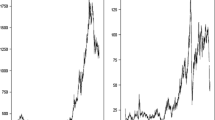Abstract
In this paper, the interdependence between aggregate commodity prices and world gross domestic product (GDP) is studied by performing two empirical exercises with long-run data that starts in the nineteenth century. Long−term and medium-term cycles are computed and their degree of synchronization measured for different leads and lags. Causality tests are performed on the frequency domain. Both exercises deepen understanding of these macroeconomic relationships by disentangling them on the time and frequency dimensions, respectively. The results show evidence of cycle synchronization only in the case of super cycles. There is causality evidence from GDP to aggregate commodity prices mostly for long-run frequencies. Therefore, commodity-price trends and super-cycles are demand driven. There is causality evidence between oil-prices and GDP in both causation directions. However, oil-price fluctuations are predictive of GDP for business-cycle frequencies only. Overall, a frequency-domain approach is useful for identifying significant variation in the interdependence between commodity prices and GDP across fluctuation horizons.




Similar content being viewed by others
Notes
An example of this type of assessments is Morgan Stanley (2015). This article forecast an increase in metal and mineral prices due to the predicted industrial recovery in China. However, its authors warned that this prediction could fail if producer companies did not use enough “supply discipline”.
Diverse studies estimate the cyclical components of business activity using filtering methodologies based on BP filters. Recent examples of these works are Comin and Gertler (2006), Borio (2014) and Drehmann et al. (2012). The BP filter was developed by Baxter and King (1999) and Christiano and Fitzgerald (2003).
Other recent papers have documented the relationship between recent high-growth periods in developing economies and the dynamics of RCP. Collier and Goderis (2012), Garnaut (2012) and Byrne et al. (2013) discuss this relationship. In addition, Baffes and Etienne (2016) as well as Winkelried (2016) provided recent evidence of the Prebisch-Singer hypothesis.
We thank Bilge Erten and Jose A. Ocampo for sharing with us their database on commodity prices.
The synchronization measure proposed by Harding and Pagan (2006) was also tested with qualitatively similar results.
This analysis was also performed with Kendall’s Tau correlations with very similar conclusions.
The non-metal components of the commodity-price index are basically agricultural products and raw materials (Online Supplemental Appendix Table 1).
References
Alquist, R., L. Kilian, and R. Vigfusson, (2013). Forecasting the Price of oil, In: Graham, E. and A. Timmermann (Eds), Handbook of economic forecasting, Volume 2A, Elsevier, Amsterdam, pp. 427–508.
Alquist, R., Bhattarai, S., & Coibion, O. (2019). Commodity-Price Comovement and global economic activity. Journal of Monetary Economics, In Press. https://doi.org/10.1016/j.jmoneco.2019.02.004.
Baffes, J., & Etienne, X. (2016). Analyzing food Price trends in the context of Engel’s law and the Prebisch-singer hypothesis. Oxford Economic Papers, 68(3), 688–713.
Baxter, M., & King, R. (1999). Measuring business cycles: Approximate band-pass filters for economic time series. The Review of Economics and Statistics, 81(4), 575–593.
Borio, C. (2014). The financial cycle and macroeconomics: What have we learnt? Journal of Banking and Finance, 45, 182–198.
Breitung, J., & Candelon, B. (2006). Testing for short and long-run causality: A frequency-domain approach. Journal of Econometrics, 132, 363–378.
Breitung, J., & Schreiber, S. (2018). Assessing causality and delay within a frequency band. Econometrics and Statistics, 6(C), 57–73.
Byrne, J., Fazio, G., & Fiess, N. (2013). Primary commodity prices: Co-movements, common factors and fundamentals. Journal of Development Economics, 101, 16–26.
Cashin, P., & McDermott, J. (2002). The long-run behavior of commodity prices: Small trends and big variability. IMF Staff Papers, 49(2), 175–199.
Christiano, L., & Fitzgerald, T. (2003). The band pass filter. International Economic Review, 44(2), 435–465.
Collier, P., & Goderis, B. (2012). Commodity prices and growth: An empirical investigation. European Economic Review, 56(6), 1241–1260.
Comin, D., & Gertler, M. (2006). Medium-term business cycles. American Economic Review, 96(3), 523–551.
Cuddington, J., & Jerrett, D. (2008). Super cycles in real metals prices? IMF Staff Papers, 55(4), 541–565.
Dolado, J., & Lütkepohl, H. (1996). Making Wald tests work for Cointegrated VAR systems. Econometric Reviews, 15, 369–386.
Doornik, J., & Hansen, H. (2008). An omnibus test for univariate and multivariate normality. Oxford Bulletin of Economics and Statistics, 70, 927–939.
Drehmann, M., Borio, C., and Tsatsaronis, K. (2012). Characterising the financial cycle: Don’t lose sight of the medium term! BIS working papers #380, bank for international settlements. http://www.bis.org/publ/work380.pdf
Erten, B., & Ocampo, J. A. (2013). Super cycles of commodity prices since the mid-nineteenth century. World Development, 44, 14–30.
Garnaut, R. (2012). The contemporary China resources boom. Australian Journal of Agricultural and Resource Economics, 56(2), 222–243.
Gil-Alana, L., & Gupta, R. (2014). Persistence and cycles in historical oil-Price data. Energy Economics, 45, 511–516.
Grilli, E., & Yang, M. (1988). Primary commodity prices, manufactured goods prices, and the terms of trade of developing countries: What long run shows. The. World Bank Economic Review, 2(1), 1–47.
Harding, D., & Pagan, A. (2006). Synchronization of cycles. Journal of Econometrics, 132, 59–79.
Harvey, D., Kellard, N., Madsen, J., & Wohar, M. (2017). Long-run commodity prices, economic growth, and interest rates: 17th century to the present day. World Development, 89, 57–70.
Hevia, C. (2008). Standard errors using the Delta method and GMM. Available at: http://siteresources.worldbank.org/DEC/Resources/Hevia_se_gmm.pdf
International Monetary Fund (2019a). International financial statistics. Available: https://data.imf.org/?sk=4C514D48-B6BA-49ED-8AB9-52B0C1A0179B.
International Monetary Fund (2019b). World economic outlook database. World economic and financial surveys. Available: https://www.imf.org/external/pubs/ft/weo/2019/01/weodata/index.aspx.
Jacks, D. (2019). From boom to bust: A typology of real commodity prices in the long run. Cliometrica, 13(2), 201–220.
Jerrett, D., & Cuddington, J. (2008). Broadening the statistical search for metal Price super cycles to steel and related metals. Resources Policy, 33, 188–195.
Lütkepohl, H. (2007). New introduction to multiple time series analysis. Berlin: Springer Verlag, 764 p.
Maddison, A. (2004). The world economy: Historical statistics (Vol. 274). OECD: Development Centre Studies.
Ocampo, J. A., & Parra, M. (2010). The terms of trade for commodities since the mid-nineteenth century. Journal of Iberian and Latin American Economic History, 28(1), 11–43.
Schumpeter, J. (1939). Business cycles. Volumes 1 and 2. New York: McGraw-Hill.
Morgan Stanley (2015). Digging up from Rock Bottom. Available at: https://www.morganstanley.com/ideas/metals-mining-digging-up-from-rock-bottom
Toda, H., & Yamamoto, T. (1995). Statistical inference in vector autoregressions with possibly integrated processes. Journal of Econometrics, 98, 225–255.
Wei, Y. (2013). Commodity prices, manufactured goods prices and inflation: Evidence from Japan. Economics Bulletin, 33(2), 986–992.
Winkelried, D. (2016). Piecewise linear trends and cycles in primary commodity prices. Journal of International Money and Finance, 64, 196–213.
Acknowledgements
The findings, recommendations, interpretations and conclusions expressed in this paper are those of the authors and do not necessarily reflect the view of the Central Bank of Colombia or its Board of Directors. We are grateful to Luis Fernando Melo, Ana María Fuertes and Lavan Mahadeva, the Editor and anonymous referee for their very useful comments.
Author information
Authors and Affiliations
Corresponding author
Additional information
Publisher’s Note
Springer Nature remains neutral with regard to jurisdictional claims in published maps and institutional affiliations.
Electronic supplementary material
ESM 1
(DOCX 22 kb)
Rights and permissions
About this article
Cite this article
Ojeda-Joya, J.N., Jaulin-Mendez, O. & Bustos-Peláez, J.C. The Interdependence Between Commodity-Price and GDP Cycles: A Frequency-Domain Approach. Atl Econ J 47, 275–292 (2019). https://doi.org/10.1007/s11293-019-09635-4
Published:
Issue Date:
DOI: https://doi.org/10.1007/s11293-019-09635-4




